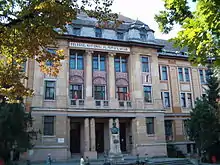
Alexandru Papiu Ilarian National College (Romanian: Colegiul Național „Alexandru Papiu Ilarian”) is a high school located at 12 Bernády György Square, Târgu Mureș, Romania.
History
The school building dates to the period when the city was part of Austria-Hungary. The work of a Budapest firm, it is U-shaped and features 112 rooms. It is 60 meters long and 45.5 meters wide, and cost nearly a million crowns. Work began in September 1912. It was ready a year later for a Roman Catholic girls’ high school to move in. During World War I, most of the school was used as a military hospital, with classes held on part of the upper story.[1]
The present institution opened in October 1919, following the union of Transylvania with Romania.[1] The building was taken over by the Romanian state, and it became a boys’ school, the language of instruction Romanian. There were originally 12 teachers and 238 pupils. By 1934–1935, the school had 589 pupils, with a corresponding rise in the number of faculty.[2] It was closed between 1940 and 1944, when Hungary controlled the area as a result of the Second Vienna Award.[1] The school library and archive were temporarily moved to Aiud.[2]
Reopened in late 1944, it functioned as a boys’ school until 1948. At that point, the new communist regime compelled the admission of girls; instruction was in Romanian and Hungarian.[1] Inspired by the Soviet educational system, the early communist authorities imposed drastic changes on the school, for example eliminating Latin, logic, sociology and religion as subjects.[3] The school was declared a national college in 1999.[1]
In front of the main entrance, there is a bust of Alexandru Papiu Ilarian, for whom the school is named.[1] The work of Ion Schmidt-Faur, it was inaugurated with great pomp in 1930.[2] It spent World War II in a corner of the Aiud high school yard,[1] and was not unveiled again in its original location until 1957.[3] The building as well as the bust are listed as historic monuments by Romania's Ministry of Culture and Religious Affairs.[4]
Faculty and Alumni
Faculty
- Endre Antalffy[5]
- Ion Chinezu (1920–1925)[6][7]: 322
Alumni
- László Bölöni (1972)[8]
- György Frunda (1970)[9][10]
- Ovidiu Papadima (1928)[11][7]: 289
Notes
- 1 2 3 4 5 6 7 (in Romanian) History Archived 2005-12-18 at the Wayback Machine at the school site
- 1 2 3 Simion, p. 743
- 1 2 Simion, p. 744
- ↑ (in Romanian) Lista Monumentelor Istorice 2010: Județul Mureș Archived 2018-12-15 at the Wayback Machine
- ↑ Róbert Oláh-Gál (July 26, 2018). "Antalffy Endre – egy nagy hatású, de elfelejtett nyelvésztudós (III.)". Népújság (in Hungarian). Retrieved November 27, 2021.
- ↑ Ciprian Farcaș. "Personalități locale – Ion Chinezu" (PDF). www.ionchinezu.sintana.ro (in Romanian). Retrieved November 27, 2021.
- 1 2 Aurel Sasu (ed.), Dicționarul biografic al literaturii române, vol. II, Pitești: Editura Paralela 45, 2004. ISBN 973-697-758-7
- ↑ Simion, p. 745
- ↑ György Frunda. "Curriculum Vitae" (PDF). www.szkt.ro (in Hungarian). Retrieved November 27, 2021.
- ↑ Sebastian Lungu (July 3, 2013). "Topul celor mai bune licee din județul Mureș". Adevărul (in Romanian). Retrieved November 27, 2021.
- ↑ (in Romanian) Radu Băieșu, “Ovidiu Papadima — în căutarea spațiului mioritic”, National Museum of Romanian Literature
References
- (in Romanian) Virgil Bui Simion, “Alexandru Papiu-Ilarian high school in Tîrgu-Mureș, a place for the formation of great personalities”, in Journal of Romanian Literary Studies, nr. 13/2018, pp. 743–47
External links
- (in Romanian) Official site